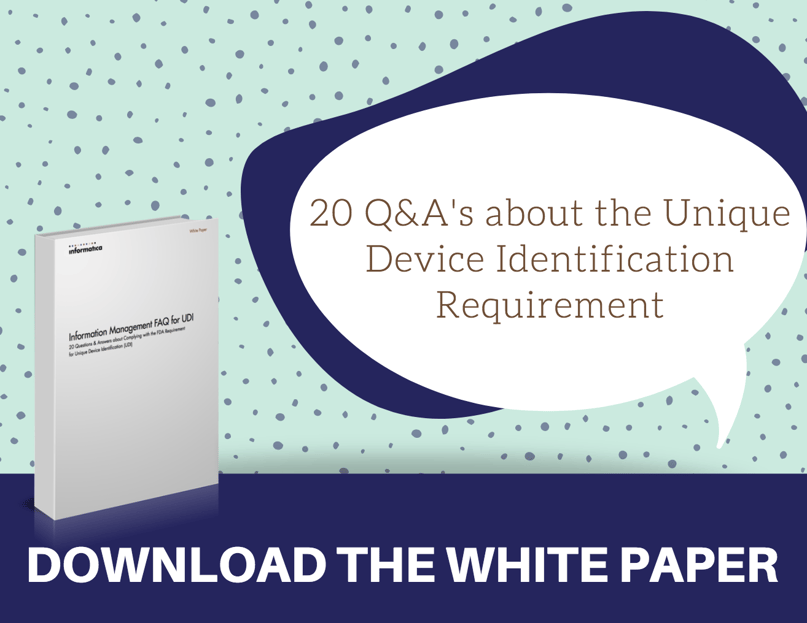
What is UDI?
The responsibility for UDI compliance falls largely on device labelers, who must include a unique device identifier on all non exempt medical devices and packages. UDI barcodes are composed of two parts. The device identifier (DI) indicates the labeler and device model, while the production identifier (PI) may indicate batch number, serial number, manufacture date, or expiration date. The FDA's final rule includes several exceptions and alternatives for certain devices, in order to minimize the cost of burden placed on labelers.
Learn more about what labelers must to do comply in our next UDI article > >
UDI numbers must come from an FDA-accredited issuing agency. At this point in time, there are three appointed agencies, which the FDA will keep updated here. Those three agencies are:
- GS1 in Lawrenceville, New Jersey
- Health Industry Business Communications Council (HIBCC) in Phoenix, Arizona
- ICCBBA in San Bernardino, CA
Who does UDI apply to?

UDI mostly pertains to 'labelers' of medical devices. The FDA defines a 'labeler' as "any person who causes a label to be applied to a device, or who causes the label of a device to be modified, with the intent that the device will be commercially distributed without any subsequent replacement or modification of the label." In essence, the last person to touch the device's label before it is distributed is the person who is required to comply with UDI guidelines.
Labelers are most often the device manufacturers, but this is not always the case. The labeler could also be a repackager, reprocessor, relabeler, kit assembler, or specification developer. Whether or not a company is responsible for a UDI label depends on what type of medical device they process and where in the supply chain they handle it.
Where will UDI take effect?
Medical devices used in the United States must comply with the FDA's UDI rules. However, the United States is not the only country working to implement a Unique Device Identification System. Both the European Commission and the International Medical Device Regulator Forum (IMDRF) are promoting UDI in the hopes of creating a global Unique Device Identification system. These organizations have been working with the FDA to create global UDI standards that might one day be enforced across all countries.
While the healthcare industry is far from realizing that dream, substantial steps have been taken towards it. For instance, device labelers in the U.S. must submit data on each labeled device to the FDA's Global Unique Device Identification Database, or GUDID. This database may one day be used as a reference catalog for all unique devices identifiers in the world.
Why was UDI created?
The Unique Device Identification System will benefit healthcare providers, manufacturers, and individual consumers by enabling:
- Faster recalls
- A reduction in medical errors
- More informed patient treatment
- Improved inventory management
- Doctors to spend more time with patients
- A reduction in counterfeit medical devices
- Faster discovery of flawed medical devices
- A better assessment of device performance
- The creation of a world-wide medical device identification system
When must I be UDI compliant?

Various UDI deadlines were spread over a period of seven years. The final rule was released by the FDA in 2013. Since then, three deadlines have passed while two are forthcoming. For all deadlines, UDI data must be submitted to GUDID.
September 24, 2014
Devices licensed under the Public Health Service (PHS) Act must have a UDI barcode. Packaging of class III medical devices are also required to have UDI barcodes. A one-year extension was available for companies who requested it before June 23, 2014.
September 24, 2015
UDI labels must be applied to medical devices or stand-alone software that are deemed life-sustaining, life-supporting, or implantable. A UDI label must be applied permanently to the body of the device if it is designed to be used more than once.
September 24, 2016
Class III medical devices must bear a UDI on the device itself, if designed to be used more than once. The packaging and labels of all class II medical devices and class II stand-alone software must have UDI labels.
September 24, 2018
Class II devices that are intended to be used multiple times must have a UDI directly on the device. The packaging of class I medical devices, class I stand-alone software, and any medical devices that are not categorized in class I, II or III must have UDI labels.
September 24, 2020
Class I medical devices must have a UDI on the body of the device if it will be used multiple times. This also applies to all medical devices that do not fall into class I, II or III.
September 24, 2022
After receiving numerous requests for extensions, the FDA has extended the deadline for the direct marking of Class I and unclassified medical devices. UDI labeling and GUDID data submission for these devices still fall under the 2020 deadline.
The FDA said, "after fully considering the time needed to meet UDI requirements, many labelers asked (the) FDA for extensions to comply. In addition, we identified complex policy and technical issues that need resolution, such as how UDI applies to products such as medical procedure trays that contain implantable devices and instruments. Providing accurate and timely support to labelers has also been challenging, due to the sheer number and wide diversity of devices."

Posted by PDI Marketing Team
Pacific Data Integrators Offers Unique Data Solutions Leveraging AI/ML, Large Language Models (Open AI: GPT-4, Meta: Llama2, Databricks: Dolly), Cloud, Data Management and Analytics Technologies, Helping Leading Organizations Solve Their Critical Business Challenges, Drive Data Driven Insights, Improve Decision-Making, and Achieve Business Objectives.

Posted by PDI Marketing Team
Pacific Data Integrators Offers Unique Data Solutions Leveraging AI/ML, Large Language Models (Open AI: GPT-4, Meta: Llama2, Databricks: Dolly), Cloud, Data Management and Analytics Technologies, Helping Leading Organizations Solve Their Critical Business Challenges, Drive Data Driven Insights, Improve Decision-Making, and Achieve Business Objectives.





